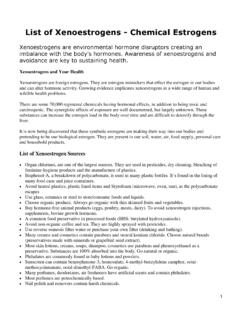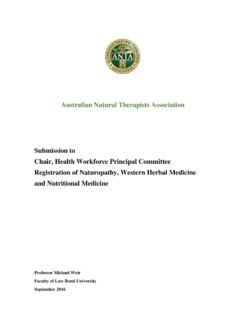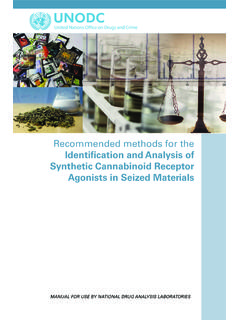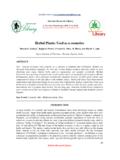Transcription of Regulatory Q&A on herbal medicinal products
1 7 Westferry Circus Canary Wharf London E14 4HB United Kingdom An agency of the European Union Telephone +44 (0)20 7418 8400 Facsimile +44 (0)20 7523 7051 E-mail Website European Medicines Agency, 2017. Reproduction is authorised provided the source is acknowledged. 21 November 2017 EMA/HMPC/345132/2010 - Committee on herbal medicinal products (HMPC) Regulatory Q&A on herbal medicinal products Table of contents (R1) Are there any limitations in the number/percentage of excipients in herbal teas? .. 2 (R2) Are medicinal products containing D-camphor, levomenthol, 1,8-cineol, thymol or rutoside as active substances eligible for traditional use registration? .. 2 (R3) Are the medicinal products containing propolis eligible for traditional-use registration?
2 3 (R4) What dosages of vitamins and minerals are acceptable in traditional herbal medicinal products eligible for simplified registration? .. 3 (R5) Is reference to organic farming acceptable in either the labelling or in the package leaflet of a herbal medicinal product ? .. 4 (R6) What kinds of safety data are required for applications according to Article 16a of Directive 2001/83/EC in case of Ayurvedic preparations? .. 4 (R7) How can I relate my product to a EU herbal monograph where herbal preparations are listed and have well established medicinal use indications? .. 5 (R8) How can I relate my product to an EU herbal monograph where herbal preparations are listed with traditional medicinal use indications?
3 6 (R9) Are herbal medicinal products which fulfil the medicinal use requirement of 30 years in a Member State which acceded recently to the EU eligible for the simplified registration procedure (or traditional-use registration)? .. 7 (R10) Are herbal medicinal products with medicinal use in Iceland, Liechtenstein and Norway ( EEA EFTA States) throughout a period of at least 30 years eligible for the simplified registration procedure? .. 7 (R11) Are medicinal products , which have been extensively used for 10 years in a Member State before its accession to the EU, eligible to demonstrate their well-established use according to Article 10a of Directive 2001/83/EC? .. 8 (R12) Are medicinal products , which have been extensively used for 10 years in an EEA EFTA State eligible for demonstration of well-established use according to Article 10a of Directive 2001/83/EC?
4 8 (R13) Can the data which formed the basis for the granting of a Swiss marketing authorisation be eligible for demonstration of well-established use according to Article 10a of Directive 2001/83/EC?.. 8 (R14) Is a European Union monograph equivalent to a summary of product characteristics (SmPC)? .. 9 Regulatory Q&A on herbal medicinal products Page 2/9 EMA/HMPC/345132/2010 Regulatory Q&A on herbal medicinal products Question (R1) Are there any limitations in the number/percentage of excipients in herbal teas? Answer The use of excipients in herbal medicinal products is regulated by Directive 2001/83/EC. Guidance on excipients include: - the Commission guideline Excipients in the label and package leaflet of medicinal products for human use - the Guideline on excipients in the dossier for application for marketing authorisation of a medicinal product - the Note for guidance on inclusion of antioxidants and antimicrobial preservatives in medicinal products The pharmaceutical legislation does not provide particulars for excipients use in traditional herbal medicinal products as the quality aspect of the medicinal product is independent of its traditional use.
5 The legislation does not impose any limitation to the number/percentage of excipients in herbal teas. However, the scientific opinion of the HMPC is that: - usually no more than 3 excipients should be used in a herbal tea (more than 3 excipients imply technical obstacles in terms of quality testing) and excipients should not represent more than 30% of the total weight - more than 3 excipients or more than 30% of the total weight in a herbal tea would not raise concerns from a public health viewpoint provided that the marketing authorisation holder/traditional use registration holder can control the quality of the product and that appropriate justification on the need for more than 3 excipients is given by the marketing authorisation holder/traditional use registration holder.
6 Question (R2) Are medicinal products containing D-c amphor, levomenthol, 1,8-cineol, thymol or rutoside as active substances eligible for traditional use registration? Answer Traditional herbal medicinal products exclusively contain as active ingredients herbal substances and/or herbal preparations. Vitamins and minerals with ancillary action may be present. According to Directive 2001/83/EC, herbal preparations are obtained by subjecting herbal substances to treatments such as extraction, distillation, expression, fractionation, purification, concentration or fermentation. Upon clarification by the European Commission it became evident that this list of possible treatments mentioned in Article 1 of the Directive is not exhaustive; moreover no limits regarding the level of Regulatory Q&A on herbal medicinal products Page 3/9 EMA/HMPC/345132/2010 purification or concentration are defined.
7 D-camphor, levomenthol, 1,8-cineol, thymol and rutoside have a long tradition of medicinal use in the EU and are often used in combination with herbal substances/ herbal preparations in herbal medicinal products . Taking into account the long-standing use of these ingredients also in combination with herbal substances and/or herbal preparations thereof, the HMPC is of the opinion that these compounds are eligible for traditional use registration, provided that they are of herbal origin, that their quality complies with the respective monograph of the European Pharmacopoeia, where appropriate, and that the medicinal product itself fulfils all requirements for a traditional herbal medicinal product as laid down in Directive 2001/83/EC.
8 The declaration of the particular ingredient in the SmPC should follow the title of the respective monograph of the European Pharmacopoeia or, when absent, of other national Pharmacopoeias or follow other conventional naming references. Currently, substances of synthetic origin remain unacceptable as active ingredients for traditional herbal medicinal products . Question (R3) Are the medicinal products containing propolis eligible for traditional-use registration? Answer The HMPC considers that propolis does not meet the legal definition of herbal substances or herbal preparations laid down in Directive 2001/83/EC. The literature classifies propolis as a natural substance of animal origin. As a result of the action of the bees in the course of collection, it is not possible to precisely define the plant part and botanical binomial name as required by the legislation.
9 In addition, it is not clear how the substances collected by the bees are modified. Therefore, products containing propolis are not eligible for traditional use registration. Attention should be paid to the possible extension of the scope of the traditional use registration procedure to products other than herbal substances with a long tradition of safe use including substances of animal, mineral or metallic origin and micro-organisms (such as honey, royal jelly, propolis, fish oils, minerals, micro-organisms and other substances ). Please see the Communication from the Commission to the Council and the European Parliament concerning the Report on the experience acquired as a result of the application of the provisions of Chapter 2a of Directive 2001/83/EC, as amended by Directive 2004/24/EC, on specific provisions applicable to traditional herbal medicinal products .
10 :2008:0584:FIN:en:PDF Question (R4) What dosages of vitamins and minerals are acceptable in traditional herbal medicinal products eligible for simplified registration? Answer Article 16a(2) of Directive 2001/83/EC states that Notwithstanding Article 1(30), the presence in the herbal medicinal product of vitamins and minerals for the safety of which there is well-documented evidence shall not prevent the product from being eligible for registration [..] provided that the action of the vitamins or minerals is ancillary to that of the herbal active ingredients regarding the specified claimed indication(s) . The pharmaceutical legislation does not impose any limitation to the dosage of vitamins and minerals.

















